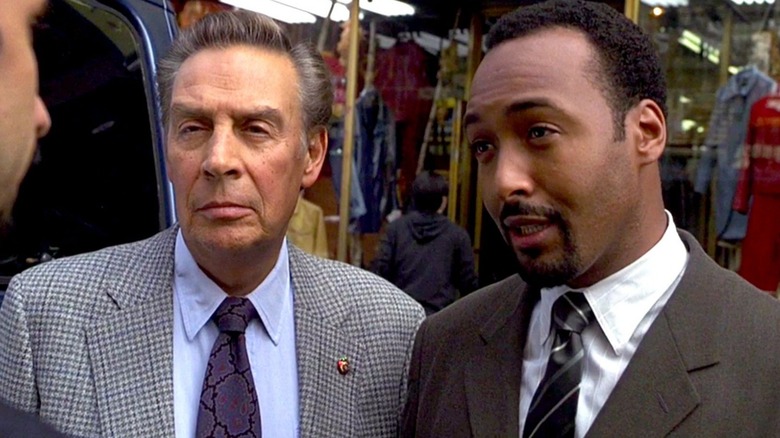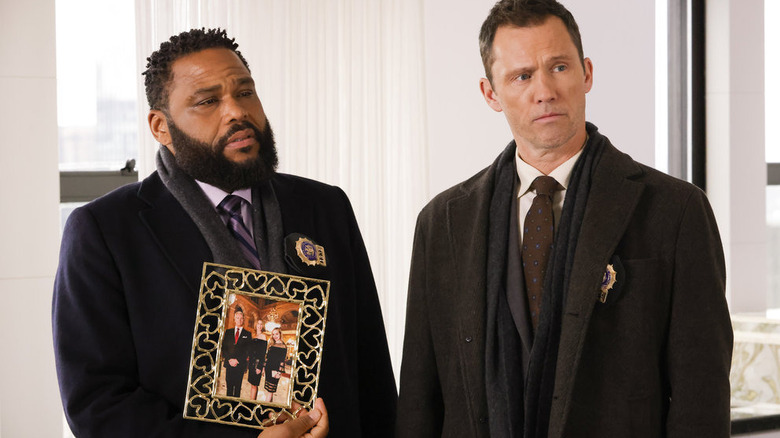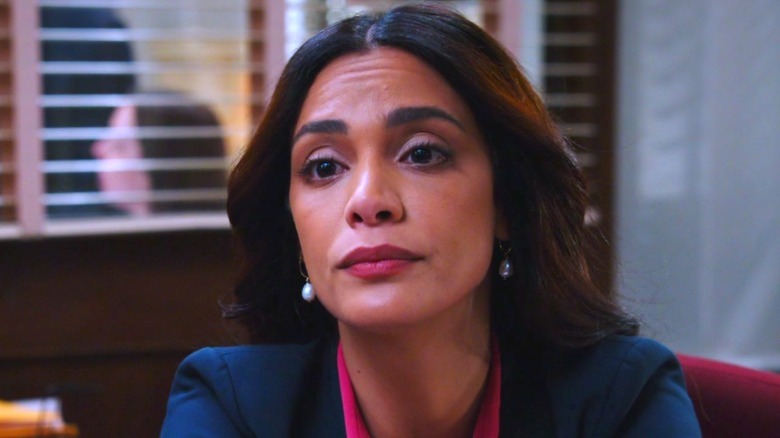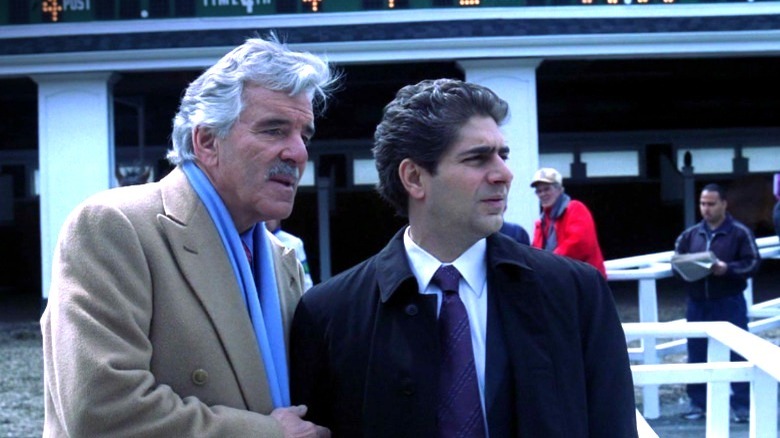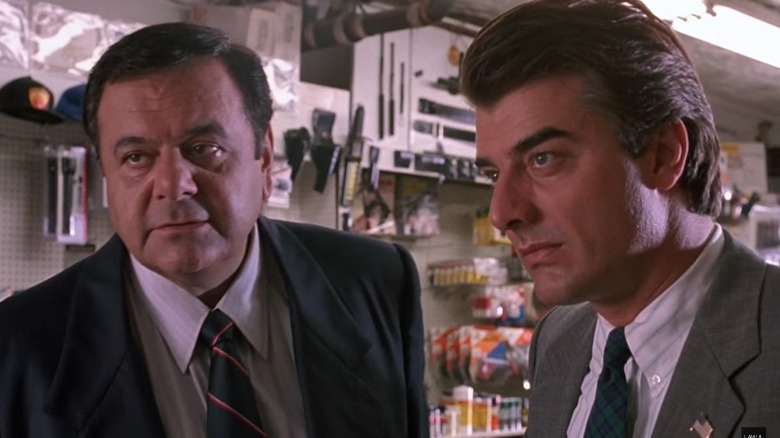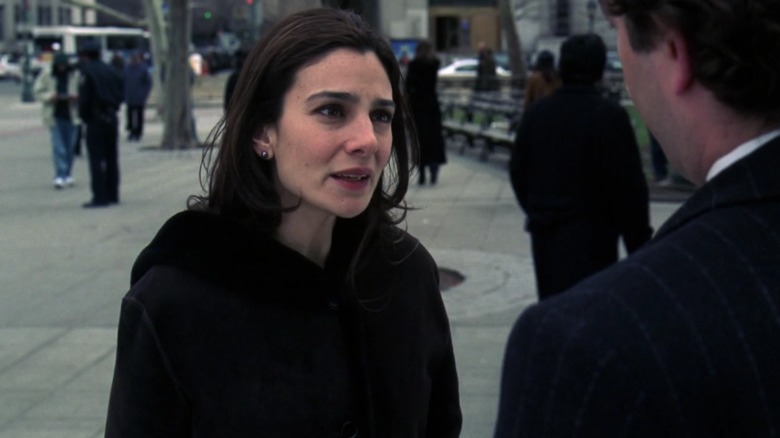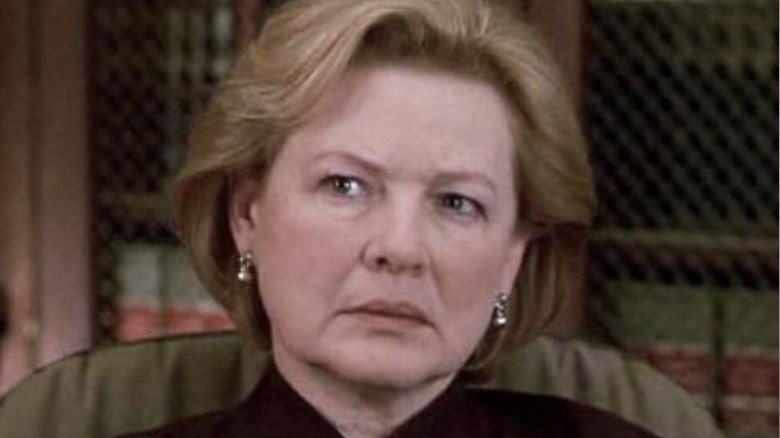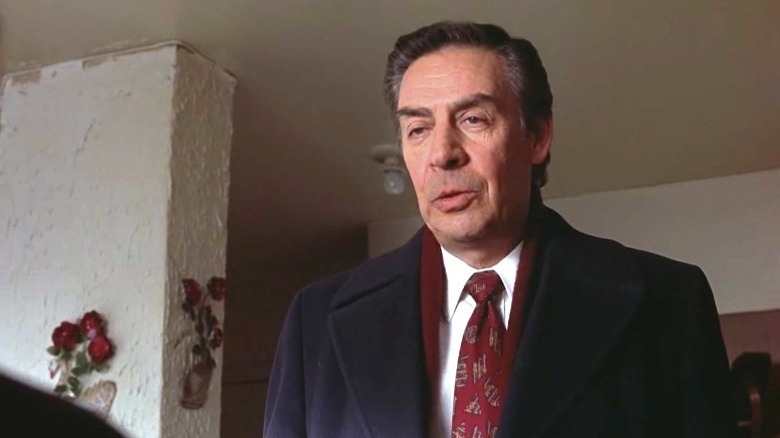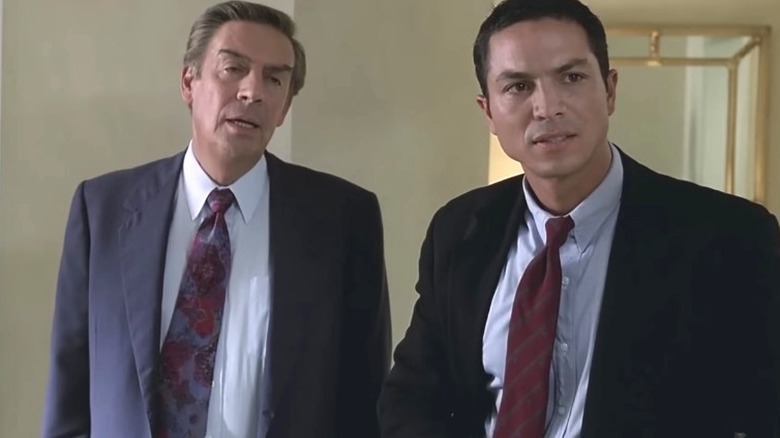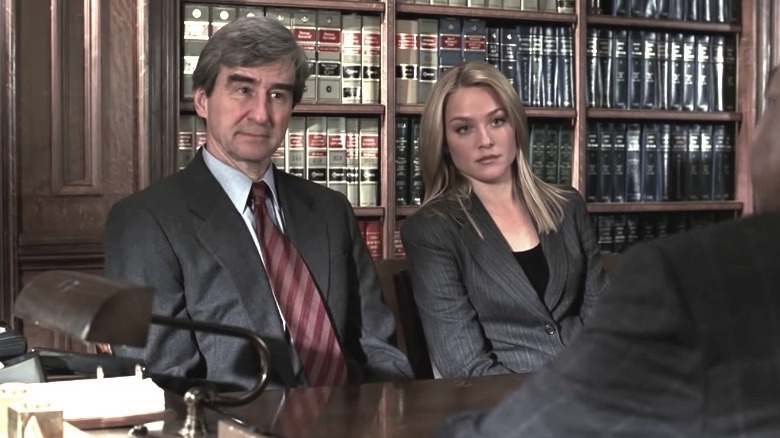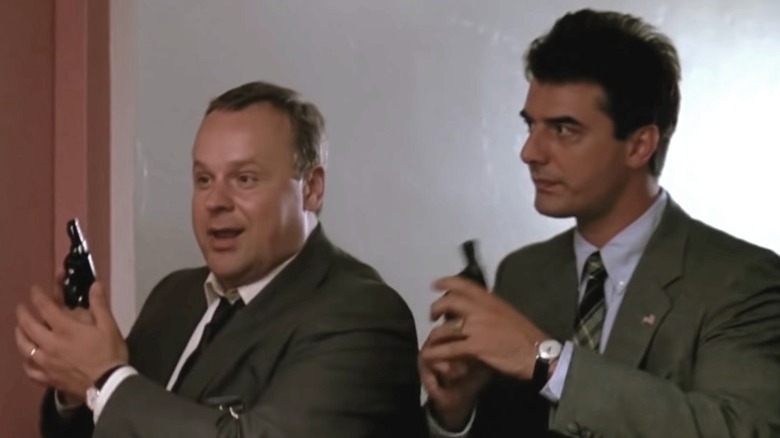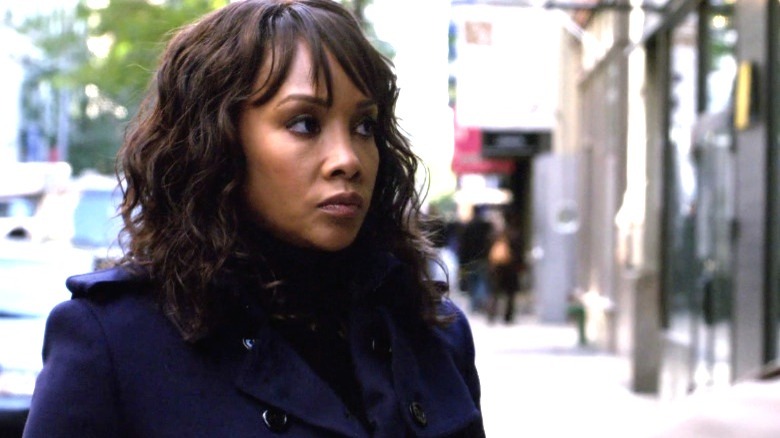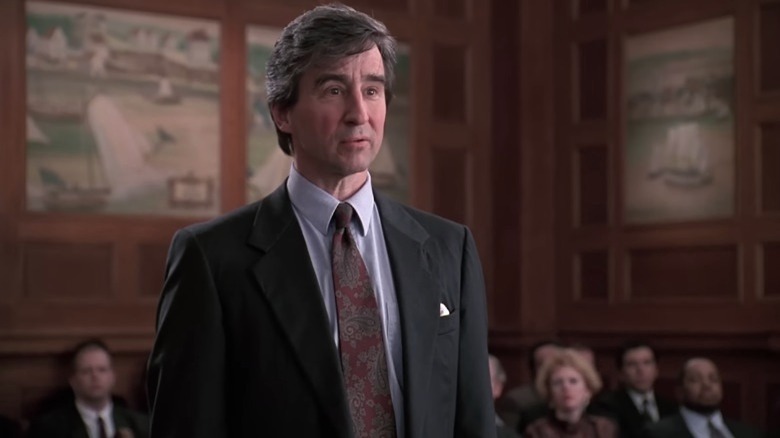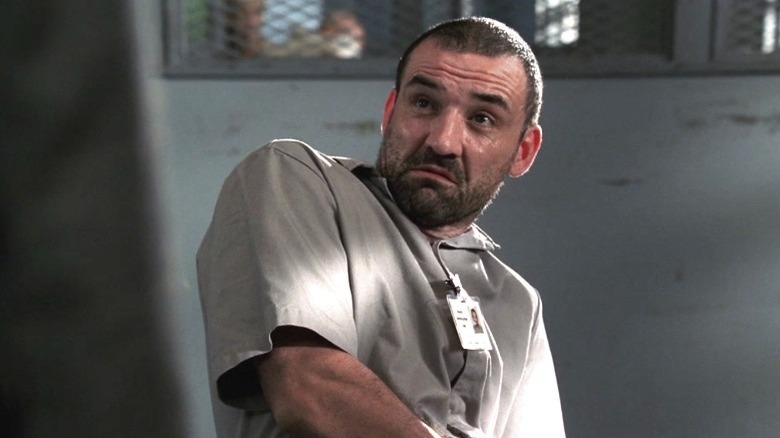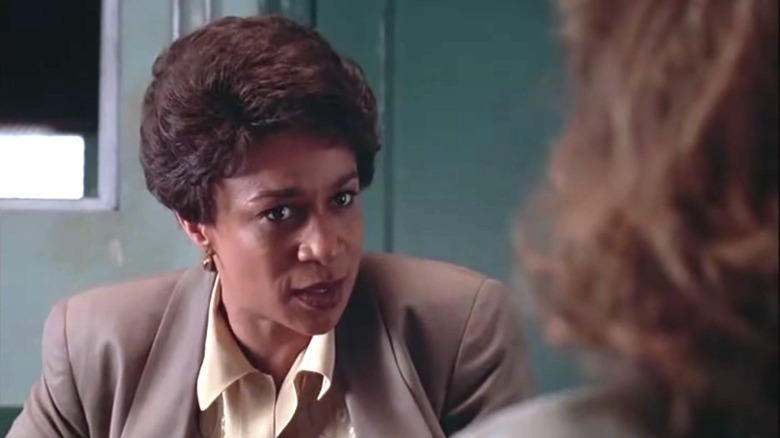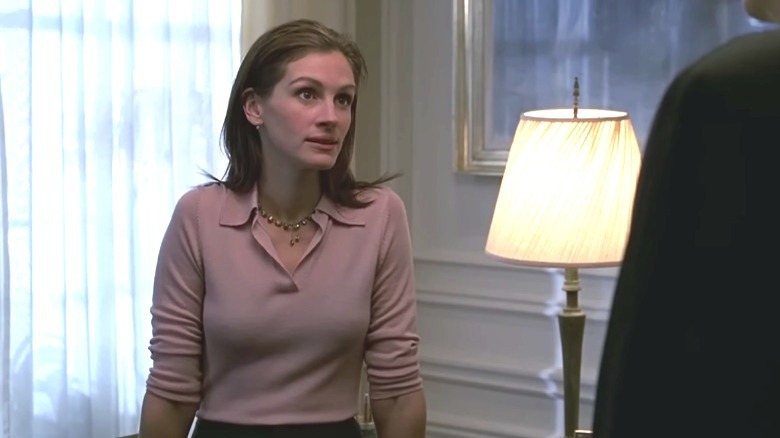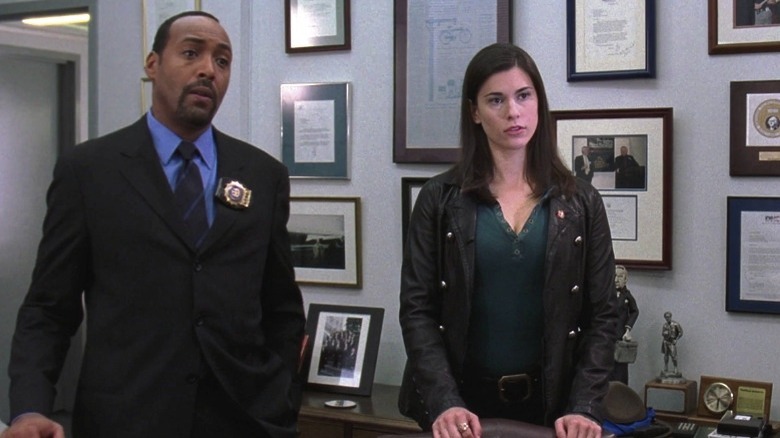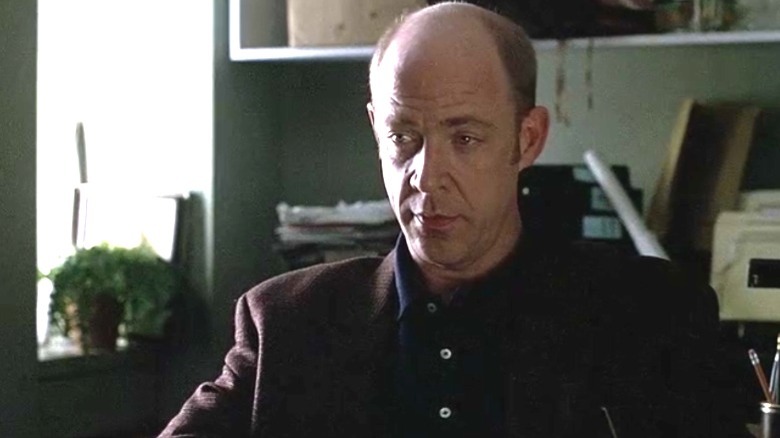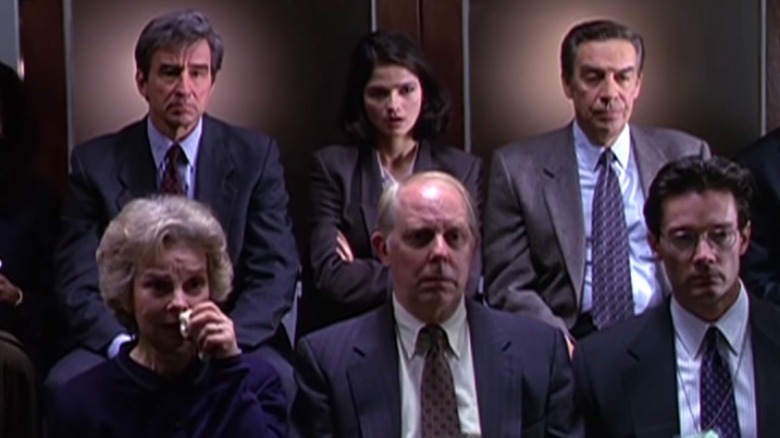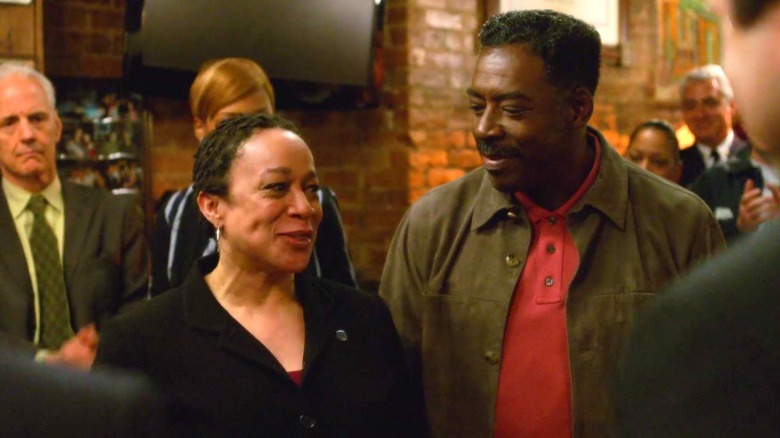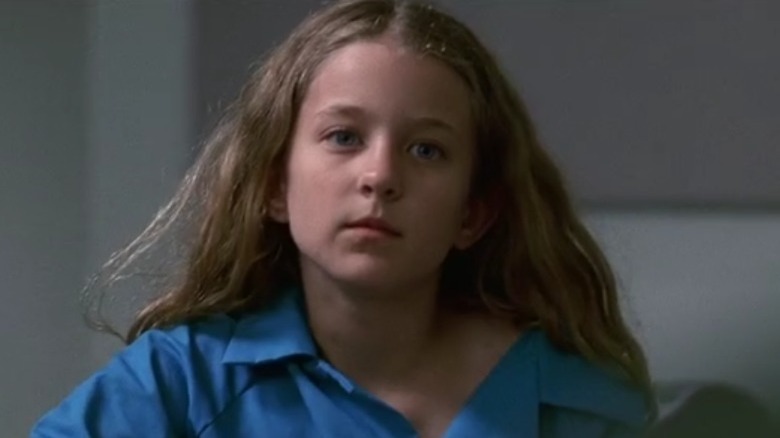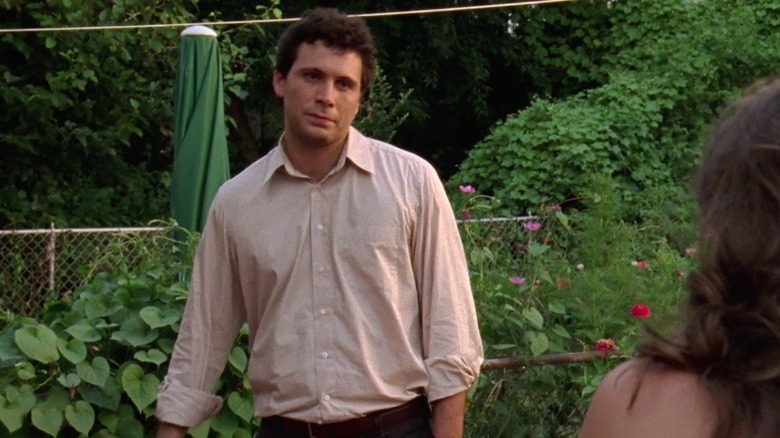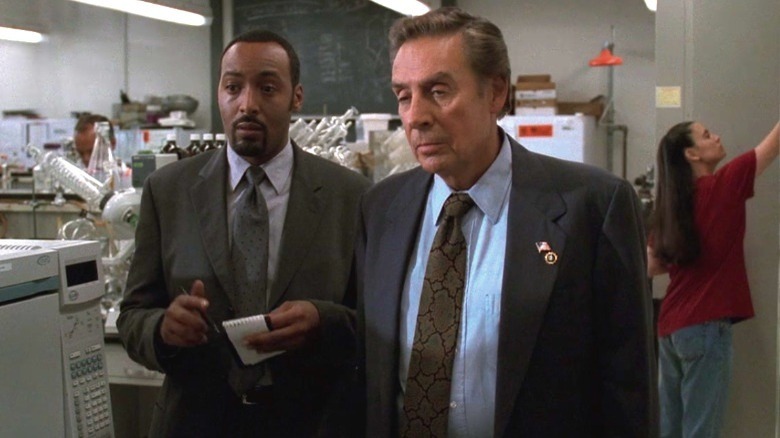Every Law & Order Season Ranked Worst To Best
Since its premiere in 1990, "Law & Order" has become the gold standard of police procedurals. It was by no means the first police procedural (1951's "Dragnet" holds that honor, according to The New York Times), but it is perhaps the most recognizable. True to its genre, each episode of this series features a crime that must be solved by detectives and prosecuted by the District Attorney's office. Although some storylines are original ideas, many take inspiration from high-profile cases, larger-than-life criminals, and current events within the U.S. justice system.
After three decades and counting, fans can enjoy over 400 episodes and 22 seasons of their favorite procedural. It's a massive chunk of television to sift through, but some parts of the series are more worthwhile than others. From unbearable characters to stale plots, the worst seasons of "Law & Order" are full of frustrating departures from the series' tried-and-true formula. However, the best seasons offer viewers a glimpse at just how great procedural television can be, even years after their premiere.
22. Season 21
After waiting over a decade for new episodes, "Law & Order" fans had high expectations for season 21. Sam Waterston and Anthony Anderson reprised their roles from the mothership series, and the list of new characters looked promising. Unfortunately, most of the reboot's first outing is disappointing. "Burn Notice" star Jeffrey Donovan looks downright uncomfortable as Frank Cosgrove, a detective who's perpetually moments away from a temper tantrum. While Anderson's Detective Kevin Bernard once had some depth, his primary purpose in season 21 is talking Cosgrove off one subtly (and sometimes not-so-subtle) racist ledge after another.
Although no one expects earth-shattering soliloquies from characters on a procedural, the dialogue in season 21 is terrible. Gone are the zippy jokes and sarcastic comments that gave the series its distinctive New York City vibe. Instead, viewers must watch the otherwise talented actors struggle through awkward conversations. Furthermore, season 21 frequently trades cases that are ripped-from-the-headlines for over-packed episodes that tackle too many current events. One exception is the season finale, "Black and Blue," which feels more like the "Law & Order" fans knew and loved. The saving grace for this season is its brevity: Since it ran as a mid-season replacement, it's only 10 episodes long.
21. Season 22
Season 22 is stronger than its predecessor, but the "Law & Order" reboot still lags behind the original run. The dialogue remains cringeworthy, and almost everyone is on a soap box. ADA Samantha Maroun (Odelya Halevi) falls flat this season because nearly every issue becomes a hill for her to die on, making her seem preachy instead of principled. Compared to the strong female ADAs of previous seasons, Maroun continues to be a disappointment. However, audiences do begin to learn more of her story as the season unfolds, including her struggles to cope with her sister's murder.
Sadly, even promising newcomer Junior Detective Jalen Shaw (Mehcad Brooks), becomes embroiled in ridiculous moral posturing in "The System." Whereas Shaw initially seems like the series' voice of reason, this episode features an overblown, borderline irrational display of guilt about his conduct during a previous case. In just one episode, he goes from being the most dynamic character in the reboot to one-dimensional and off-putting. Of course, the icing on this flavorless cake is the season premiere, "Gimme Shelter," the conclusion of a three-part crossover with "SVU" and "Organized Crime." The only watchable moments in it feature characters from the other two series.
20. Season 15
Some "Law & Order" detectives become instant fan favorites, while others are nearly impossible to love. In season 15, Detective Joe Fontana (Dennis Farina) replaces the widely beloved detective Lennie Briscoe (Jerry Orbach). Unfortunately, Detective Fontana's combative attitude rubs viewers — and his fellow officers — the wrong way. After his first eye-roll-inducing interaction with Lieutenant Van Buren (S. Epatha Merkerson) in "Paradigm," it's clear that the new detective is just not a people-person. Instead, he's a brash know-it-all with no respect for authority, and subsequent episodes do little to soften that impression.
Season 15 also suffers from another (albeit temporary) cast change: Jesse L. Martin takes a four-episode hiatus from playing Detective Ed Green to participate in the film adaptation of "Rent." Green's replacement, Detective Nick Falco (Michael Imperioli), is almost as stubborn as Fontana. Although he reveres the justice system, his personality is simultaneously abrasive and overly simplistic, even for a character on a procedural. While Green's smooth, calm attitude perfectly balances Fontana's hot-headed tendencies, Falco just adds fuel to the already annoying fire. The two detectives butt heads less often than expected, but their short-lived partnership makes season 15 the worst of the original series.
19. Season 2
When it comes to procedurals, casting is everything. Sure, the cases are intriguing, but the real forward momentum of a show like "Law & Order" comes from the relationships between central characters. Season 2 follows detectives Mike Logan (Chris Noth) and Phil Cerreta (Paul Sorvino) as they hunt down criminals and try to build a professional bond. After the death of his first partner, Max Greevey (George Dzundza), it makes sense that Logan has misgivings about Cerreta. Nevertheless, Logan's initial resentment of his new partner makes it difficult for viewers to settle into the season.
Logan is well-known for his quick temper and gruffness, and season 2 demonstrates some of his worst behavior. In the first episode, "Confession," Logan goes too far in obtaining a confession from Greevey's supposed killer, which jeopardizes the prosecution's entire case. Although he's grieving his partner, it isn't easy to sympathize with a character hell-bent on having his own way. His attitude gradually softens as season 2 progresses, and things are much more harmonious between Logan and Cerreta in later episodes. However, the two end up being partners in shady police work entirely too often for this to be a worthwhile season.
18. Season 16
Although "Law & Order" follows a predictable formula on-screen, season 16 was messy behind the scenes, as several cast members abandoned ship. Annie Parisse asked to leave the show, and Dennis Farina followed her out the door, ending his tenure after only two seasons. Unsurprisingly, their characters' departures completely overshadow the rest of the season finale. Parisse's character, ADA Alexandra Borgia, dies in brutal fashion right after the opening credits roll, while Fontana retires peacefully.
Even before the finale, though, this season is all over the place. The worst-behaved characters are in rare form, outdoing their own awful behavior without facing significant consequences. Fontana, for example, gets into hot water for his off-book investigative tactics, but somehow emerges unscathed. McCoy's ambition becomes problematic in multiple episodes, which makes it difficult to support his prosecutorial decisions. Worse, Detective Falco returns for an unbelievable case and behaves like it's his first day on the job. Detectives find a woman murdered in his apartment, and he spends the entire episode hindering their ability to find him innocent. Season 16 does feature a decent crossover with "Law & Order: SVU," but it isn't enough to save the season from itself.
17. Season 11
When Adam Schiff (Steven Hill) passed the baton to District Attorney Nora Lewin (Dianne Wiest), fans finally saw a female character assume the head prosecutor position. However, despite Wiest's many talents, DA Lewin is an immediate letdown. Rudy Giuliani makes a cameo to introduce her as the interim district attorney, but the fanfare quickly fades as the season premiere, "Endurance," unfolds. During their first case together, McCoy goes against his new boss' wishes with barely a second thought, and Lewin is woefully ineffective at stopping his behavior. Although McCoy is known for breaking the rules, Lewin's lack of authority is disappointing.
Unfortunately, the way the series employs a highly decorated actress to play a throw-away character detracts from the great things season 11 offers. For example, the season ends with a compelling two-part finale, which is rare for "Law & Order." A handful of other genuinely thought-provoking episodes are also worth watching, but Lewin distractingly fades into the background of every scene. Moreover, her one-note politics contribute nothing to the philosophical debates that make the prosecutor's office intriguing. Audiences deserved a female DA as dynamic and skilled as the many female ADAs in the series; Lewin is simply forgettable.
16. Season 3
The first few seasons of "Law & Order" were plagued by cast shakeups, but season 3 is when things start coming together. Hot-tempered Mike Logan finally meets his match with the mid-season debut of Detective Lennie Briscoe. While Logan is young and self-assured, Briscoe brings worldly experience to the table, finally giving Logan the balance he needs. In addition, Briscoe's dry sense of humor is an instant hit, and soon becomes his defining characteristic. Although the two don't get along at first, the detectives eventually build the first truly successful pairing of the series.
However, settling into a more stable team-up curtails the police drama. As a result, many cases don't hit as hard as in other, more successful seasons. Nevertheless, while many episodes are pretty pedestrian, highlights like "Manhood" and "Helpless" are worth watching. Furthermore, season 3 is memorable for its surprising amount of continuity. Instead of cases that exist in a vacuum, a few mid-season plot threads play out across multiple non-consecutive episodes. This twist on the usual "Law & Order" formula is less common in the early seasons, and it sets an intriguing precedent.
15. Season 7
There's no denying that Benjamin Bratt excels at playing men in uniform. Those who love Detective Rey Curtis will especially enjoy season 7, which includes some of his best moments. Although Mike Logan defined the hot-headed young "Law & Order" detective, Curtis does it with much more finesse. He steps out of line sometimes, but he has a clearly defined moral compass. From his crew cut to his ever-present cell phone, Curtis provides a thoroughly modern counterpart to Detective Briscoe's relaxed, old-school style.
While the detectives are a highlight in season 7, however, the prosecutors are too predictable. McCoy and ADA Jamie Ross (Carrie Lowell) have one too many squabbles, making it unintentionally satisfying to watch McCoy struggle to keep his job in the season finale. The two gel in later seasons, but their professional growing pains make it difficult to appreciate their partnership in season 7. However, "Mad Dog" is an incredibly powerful late-season episode that every "Law & Order" fan needs to see at least once. McCoy goes on one of his best crusades for justice, and Sam Waterston earned himself a 1997 Emmy nomination for his performance.
14. Season 12
After seven seasons as the most pugnacious EADA in the business, Jack McCoy finally meets his match in season 12. The new ADA, Serena Southerlyn (Elizabeth Rohm), shares his tenacity and never backs down from a fight. Previous ADAs didn't take McCoy's stubbornness lying down, but Southerlyn's convictions are strong enough to keep her from being steamrolled — most of the time. Southerlyn also provides a necessary counterpoint to soft-spoken Interim DA Lewin, who consistently fails to command the room.
Unfortunately, as exciting as this new pairing is, season 12 is mostly made up of filler episodes devoid of the controversies and moral conundrums that make "Law & Order" such an excellent procedural. Some cases are unique, such as the unusual appearance of a so-called "rebirthing therapist" in "Born Again," but most are too simple to be noteworthy. The season is full of garden variety homicides (if such a thing exists), drug busts, and a handful of corruption cases, but none of the criminals are exceptional. It would have been nice to see Southerlyn tackle more complex issues in her first season, but season 12 nevertheless gives her a sound introduction.
13. Season 1
Many shows get off to a rocky start, but "Law & Order" had a respectably memorable beginning. It wasn't pretty and it hasn't aged well, but season 1 set a high bar in terms of character chemistry and action-packed arrests. It features Detective Logan at his most questionable, paired up with the often equally dubious Detective Greevey. While Greevey is comparatively more strait-laced, this pair of police officers will get their man by any means necessary. Their creative take-downs include some true gems, such as Logan stopping a suspect in his tracks with a trash can lid to the face.
Some of the detectives' antics teeter dangerously close to police brutality, so parts of this season can be a little tough to watch. Regardless, season 1 sets a high standard for the quality of cases the characters try to crack. When it comes to topical issues, this season outpaces several others with compelling ripped-from-the-headlines episodes. "Everybody's Favorite Bagman" reimagines a Parking Violations Bureau scandal, while the two-part episode "Torrents of Greed" takes inspiration from Jimmy Hoffa's disappearance. As a bonus, fans can catch young Philip Seymour Hoffman's first onscreen appearance in "The Violence of Summer."
12. Season 19
Season 19 featured a wide array of directors at the helm, including Mario Van Peebles, who lent his talents to the episode "Sweetie." This installment is a high point of the season, with a case that keeps audiences guessing and a refreshing appearance by Vivica A. Fox. The criminals this season are also of a higher caliber than in many others, and the plots are universally well-written. Some cases feel a little stale, such as the kidnapping and extortion storyline in "Bailout," but the season offers enough variety that it's okay to overlook a few weaker episodes.
However, while it's good, this season could have been great. Unfortunately, some lackluster performances are hard to overlook. This cast remains stable from the previous season, but familiarity breeds contempt as Detective Kevin Bernard settles into his new role. It's hard to forget him as the obnoxious, often self-righteous IAB detective from season 18, especially after his investigation of Detective Green. Where he should approach his new position on the team with a bit of humility, Detective Bernard acts like he always knows best. Furthermore, while Detective Lupo is still a great addition to the lineup, he feels much flatter than he did in his debut season.
11. Season 5
It's hard to imagine "Law & Order" without DA Jack McCoy, but this irreplaceable character didn't appear on the series until season 5. This season gives fans a fun look at McCoy's early days as a stubborn, womanizing EADA with an unrelenting desire to win cases. Love him or hate him, McCoy is the winningest prosecutor in the show's history. Even on his first day, McCoy displays his cavalier attitude. He makes the strongest first impression of almost any new character on the series, captivating both viewers and his new colleague, Claire Kincaid (Jill Hennessy). The ongoing sexual tension between these two creates an entertaining backdrop to life in the prosecutor's office.
"Law & Order" is considered a career-maker, and it's a treat to revisit some top performers' roles in the early seasons. As such, season 5 features a pair of can't-miss cameos by actresses at the beginning of their careers. "Family Values" stars the one and only Sarah Paulson as a teenager named Maggie Conner. Paulson was just a teen herself at the time, and this episode marks her first-ever television appearance. Earlier in the season, "Ozark" star Laura Linney appears in "Blue Bamboo," playing a singer accused of murdering her former boss.
10. Season 14
The season 14 premiere, "Bodies," has everything audiences want from "Law & Order": a compelling case, Jack McCoy on a rampage, and Detective Briscoe's signature one-liners. Serial killer Mark Bruner (Ritchie Coster) is one of the vilest, most memorable criminals to appear on the series. He turns his crimes into a game by refusing to reveal where he has hidden his victims' bodies. This episode sets the tone for an action-packed season featuring mob bosses, a heavy metal band, and two women who kill each other's husbands. Every episode is well-paced, and no two cases are alike.
However, for all the excellence season 14 offers, it has a bittersweet ending. The season finale, "C.O.D.," marks the last time Detective Briscoe appears in the series. The episode bids the character a fitting farewell. His career ends on a high note without much fuss — exactly as Briscoe would prefer. Although this episode is undeniably sad, the real-life tragedy awaiting actor Jerry Orbach makes re-watching Season 14 even more painful. Only months after the finale aired, Orbach died of prostate cancer. Reliving his final moments on the series is an excellent way to remember one of the best detectives in "Law & Order" history.
9. Season 4
For three seasons, "Law & Order" was just another boys' club. Then, season 4 introduced two dynamic female characters that changed the face of the series. In the season premiere, "Sweeps," Lieutenant Van Buren takes the helm of the 27th Precinct, while ADA Kincaid adds a fresh perspective to the District Attorney's office. Both share the honor of being the first female members of the main cast. They each have a solid first showing and set the bar for the female characters that follow. Even as a new supervisor, Van Buren dives headfirst into her debut case and immediately commands the respect of her detectives. Although Kincaid has a much more subdued personality, she proves herself a conscientious, intelligent young prosecutor.
This momentous season keeps the new characters busy with plenty of cases that are not what they seem to be. An early highlight for Kincaid is "Breeder," in which she relentlessly pursues the truth behind a private plot to extort couples hoping to become parents. Kincaid also receives a significant focus in "Censure" when an embarrassing event from her past threatens her new position. In a series that sometimes gives new characters a surface-level treatment, season 4 reminds viewers of the power of a good backstory.
8. Season 9
Season 9 dials up the intensity with polarizing cases that tackle racial and religious issues. Every episode gives viewers something to think about, but doesn't present an overt agenda. Fittingly, ADA Abbie Carmichael (Angie Harmon) joins the prosecution team with a conviction rate to rival Jack McCoy's. The two make a dynamite team in and out of the courtroom, even if they don't always agree. This season also features one of the show's most compelling female supporting characters: Katrina Ludlow, played by Julia Roberts, a power-hungry charity fundraiser who almost gets away with a murder conspiracy in "Empire."
After nearly two dozen action-packed episodes, season 9 comes to a touching close with the departure of longtime favorite Detective Curtis. Despite his success as a detective, Curtis puts family first and leaves the force to care for his ailing wife. Curtis' choice is heartbreaking because he experiences so much growth and turmoil throughout the season. Of all the detectives, Curtis is one of the most well-developed and realistic. He made some very questionable choices during his "Law & Order" tenure, including cheating on his wife and losing his temper with suspects, but this is a fitting end to his storyline.
7. Season 17
Ed Green is one of the most amicable "Law & Order" detectives, but even he has difficulty bonding with his new partner in season 17. Detective Nina Cassady (Milena Govich) is the first — and only — female detective on the mothership series. She joins the cast at an excellent time, since season 17 features some of the series' most memorable episodes. "Deadlock" is a particular standout, featuring an unforgettably harrowing school shooting, a well-developed criminal, and an exciting look at legal loopholes.
However, as groundbreaking as Detective Cassady is, she ultimately drags the season down. Cassady is needlessly combative, especially with Van Buren, the only other female officer at the precinct. This cat-fighting stereotype immediately undermines her character's potential, and things only get worse as the season continues. Unsurprisingly, her tenure ends after only one season. Despite Cassady's poor showing, however, season 17 is still a winner because of one highlight: ADA Connie Rubirosa (Alana de la Garza). Rubirosa makes her debut in the season premiere and quickly emerges as a prime example of how important female characters are to this franchise. Together, Rubirosa and McCoy make for the ultimate prosecutorial dream team.
6. Season 8
Although the main cast rightfully gets most of the attention, recurring characters are sometimes the unsung heroes of "Law & Order." One of the most entertaining is Dr. Emil Skoda (J.K. Simmons), a no-nonsense psychiatrist who helps the prosecutors assess suspects' mental states. Dr. Skoda makes his debut in season 8's "Denial," which follows a pair of college students who allegedly murdered their own newborn child. Dr. Skoda plays a vital role in unraveling the couple's complex story, getting his relationship with the DA's office off to a successful start.
Season 8 also features the series' best "Homicide: Life on the Street" crossover, which starts with "Baby, It's You." This crossover is fun for fans of both series, especially those who followed Detective Briscoe's early career on the Baltimore-based show. In the crossover, Briscoe gets back in touch with his former colleague, Detective John Munch (Richard Belzer), who makes a cameo in the "Law & Order" portion of the crossover. Season 8 has more cases based on true stories than any other early season, so it's also an easy favorite for true crime fans.
5. Season 6
ADA Kincaid may not be the most strong-willed prosecutor on "Law & Order," but she has one of the show's most well-written character arcs. In season 6, Kincaid and McCoy are in a groove, tackling tough cases and (mostly) agreeing on how to secure convictions. This season also features a compelling crossover with "Homicide: Life on the Street" in the episode "Charm City." In it, the New York and Baltimore detectives team up to hunt down a subway bomber, and the case leads them deep into a domestic terrorism plot. Season 6 also temporarily welcomes former ADA Paul Robinette (Richard Brooks) back into the fold in the episode "Custody."
However, what truly makes season 6 successful is its experimental, unforgettable finale episode, "Aftershock." For the first and only time, the series departs from its usual formula and follows the four main characters through quiet, solo moments. In the beginning, Briscoe, Kincaid, Curtis, and McCoy all witness a convicted man's execution, which inspires a myriad of conflicting reactions and gives fans a never-before-seen glimpse at these four characters' emotional worlds. The episode has a slower pace and a more cinematic quality than viewers are used to, and features the most tragic conclusion to any season of the show: Kincaid dies in a car crash at the end of the episode.
4. Season 20
Season 20 is chock full of notable guest appearances, including an unexpected cameo by Olympic skier Lindsey Vonn in the series finale. Comedians Jim Gaffigan, Rob Coddry, and Samantha Bee also show up in the middle of the season. However, the most noteworthy guest star is Benjamin Bratt, who reprises his role as Detective Curtis in "Fed." The detective returns to the series for his wife's funeral, inviting Van Buren to attend. This episode is one of many that highlights Van Buren's own struggles with mortality. The beloved lieutenant reveals a cancer diagnosis early in the season, which is heartbreaking for both viewers as well as her fellow officers.
Of course, the best part of season 20 is the finale, "Rubber Room." After the conclusion of a complex case, the series ends with a quiet fundraiser in Van Buren's honor. It's almost like any other after-hours event, but its finality adds a subtle bittersweetness. There's no shocking cliffhanger or bombshell twist, just a simple gathering of colleagues to support one of their own. The original "Law & Order" series didn't end with much fanfare, but Season 20 was nevertheless a perfect conclusion.
3. Season 10
When it comes to cases that will keep you up at night, no season of "Law & Order" can compete with number 10. Several episodes raise difficult moral questions that leave a lingering impression. Most notably, "Killerz" features an unlikely but terrifying criminal. 10-year-old Jenny Brandt (Hailee Hirsch) is the stuff of nightmares, a sociopathic murderer with no remorse for her crime. It's one of the few episodes that leaves audiences with a sick, sinking feeling after the credits roll, largely because nobody really wins. Jack McCoy tries to convince a judge to keep society safe by institutionalizing Jenny, but the young girl goes home in the care of her very questionable mother.
Alongside the brutal crimes and philosophical quandaries, season 10 introduces Detective Ed Green. While many previous detectives felt one-dimensional, Green has just enough backstory to give him a believable edge. His debut is rushed, but the bond he builds with Briscoe is the best of the whole series. His calm, even-keeled nature and ability to get along with anyone perfectly match Briscoe's sarcasm and occasional curtness.
2. Season 18
Of all the detective debuts, none is as seamless and well-deserved as Cyrus Lupo's (Jeremy Sisto) in season 18. Whereas most other seasons immediately throw new characters into the fray, season 18 spends a whole episode introducing this new character and integrating him into the "Law & Order" world. In the appropriately-named season premiere, "Coming Home," Lupo returns from overseas after the death of his brother. He immediately establishes himself as a likable but no-nonsense character, and the chemistry between Lupo and Green is spot-on. The two make an excellent (though underrated) pair.
The only significant problem with season 18 is that it puts a quick end to the Green-Lupo team-up. Just as Lupo receives a fitting introduction at the beginning, Detective Green gets a respectable sendoff for his mid-season departure in "Burn Card." Green's checkered history as a gambler returns to haunt him, but the beloved character receives a chance to resign with dignity. His is among the most unfortunate departures in the series, but it also receives the best writing of any established character's exit. Unfortunately, his replacement, Detective Bernard, doesn't quite measure up, making the second half of the season weaker than the first.
1. Season 13
Most seasons of "Law & Order" have some noteworthy highlights, but season 13 is the peak of procedural television. Never before or since has the series managed such a perfect lineup of characters, especially with DA Arthur Branch (Fred Dalton Thompson) taking the helm. He replaces interim DA Lewin with a keen eye for politics and a fresh perspective on justice. While previous head prosecutors had their strengths, Thompson's real-life background as a politician gives Branch a gravitas that none of the others could match. Branch's command of his team is even more impressive: He knows when to reel in the strong-willed Jack McCoy, and when to loosen the reins.
While the newly formed prosecutorial team gets into a reliable groove, the state of affairs on the "law" side of the equation is better than ever. Lieutenant Van Buren and her team tackle drug busts, hit-and-runs, and homicides with unpredictable outcomes. Detectives Briscoe and Green are at their most chummy, trading snappy jokes and pulling off expertly choreographed arrests at every turn. In the penultimate episode, "Couples," the two solve a kidnapping and multiple murder cases in the usual hour run time — all in a day's work for the greatest detective pairing in the history of "Law & Order."
